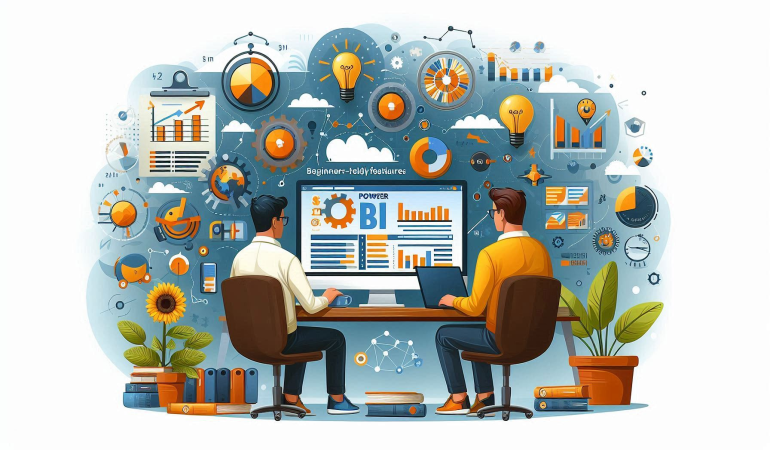
Power BI for Newbies: Beginner-Friendly Features
Jul 14, 2024
An In-Depth Look at Its Beginner-Friendly Features
Introduction
In today's data-driven world, the ability to analyze and visualize data efficiently is crucial for making informed business decisions. Power BI, a powerful business analytics tool by Microsoft, stands out as a top choice for businesses and individuals looking to transform raw data into meaningful insights. This blog aims to provide an in-depth analysis of Power BI's beginner-friendly features, making it accessible even for those new to data analytics.
What is Power BI?
Power BI is a suite of business analytics tools designed to help you visualize your data, share insights across your organization, and embed them in your app or website. It connects to hundreds of data sources, simplifies data preparation, and drives ad hoc analysis. Power BI's ability to produce beautiful reports and publish them for your organization to consume on the web and across mobile devices makes it a popular choice among businesses of all sizes.
Key Components of Power BI
Before diving into the beginner-friendly features, it's important to understand the key components of Power BI:
- Power BI Desktop: A Windows application for data analysis and report creation.
- Power BI Service: An online service for sharing and collaboration.
- Power BI Mobile: Mobile apps for viewing reports and dashboards on the go.
- Power BI Embedded: A service for embedding Power BI reports and dashboards into other applications.
- Power BI Report Server: An on-premises report server for hosting Power BI reports.
Beginner-Friendly Features of Power BI
Power BI is designed to be user-friendly, even for those with little to no experience in data analytics. Here are some of its most notable beginner-friendly features:
1. Intuitive Interface
Power BI's interface is designed to be intuitive and easy to navigate. The ribbon-based layout, familiar to users of other Microsoft Office products like Excel and Word, helps new users feel comfortable right from the start. The interface is divided into different sections, including the report view, data view, and model view, each serving a specific purpose in the report creation process.
2. Easy Data Import and Connection
One of the most daunting tasks for beginners is often the process of importing and connecting to data sources. Power BI simplifies this with its user-friendly data connection wizard. Whether you're connecting to an Excel file, a SQL database, a web service, or even a cloud-based data source, Power BI provides a straightforward, step-by-step process to get your data into the tool.
3. Data Transformation with Power Query
Data often requires cleaning and transformation before it can be effectively analyzed. Power BI includes Power Query, a powerful data transformation and cleansing tool that uses a simple, intuitive interface. With Power Query, you can filter rows, remove duplicates, merge tables, and perform a variety of other data transformation tasks without needing to write any code. The Query Editor provides a clear and concise way to see the steps you've applied to your data, making it easy to modify or undo changes.
4. Drag-and-Drop Functionality
Creating visualizations in Power BI is as simple as dragging and dropping fields onto the report canvas. This feature is particularly beneficial for beginners who may not be familiar with more complex data visualization tools. Power BI automatically generates the visualization based on the data you select, and you can easily switch between different types of visualizations (e.g., bar charts, pie charts, line charts) with just a few clicks.
5. Built-In Visualizations and Custom Visuals
Power BI comes with a wide variety of built-in visualizations, including bar charts, line charts, pie charts, scatter plots, maps, and more. These visualizations are highly customizable, allowing you to adjust colors, labels, and other properties to suit your needs. Additionally, Power BI supports custom visuals, which can be downloaded from the Microsoft AppSource marketplace or created by users with specific needs. This flexibility ensures that you can always find or create the perfect visualization for your data.
6. Natural Language Query (Q&A)
Power BI's Q&A feature allows users to ask questions about their data using natural language. This means you can simply type a question like "What were the total sales last month?" and Power BI will generate the appropriate visualization to answer your question. This feature is particularly helpful for beginners who may not know how to create complex queries or reports manually.
7. Interactive Reports and Dashboards
Power BI enables the creation of interactive reports and dashboards that allow users to explore data in a dynamic way. You can add slicers, filters, and drill-down capabilities to your reports, making it easy for users to interact with the data and find the insights they need. This interactivity makes reports more engaging and useful, especially for presentations and decision-making processes.
8. Integration with Other Microsoft Products
For users already familiar with Microsoft Office products, Power BI's integration with tools like Excel, SharePoint, and Teams is a major advantage. You can easily import Excel data into Power BI, share reports via SharePoint, and collaborate on data analysis within Teams. This seamless integration makes it easier for beginners to incorporate Power BI into their existing workflows.
9. Comprehensive Learning Resources
Microsoft provides a wealth of learning resources to help new users get started with Power BI. The official Power BI website offers tutorials, documentation, and guided learning paths. Additionally, there are numerous online courses, forums, and community groups where users can seek help and share knowledge. This extensive support network ensures that beginners have access to the information they need to become proficient in Power BI.
10. Affordable Pricing and Free Version
Power BI offers a free version with a robust set of features, making it accessible to individuals and small businesses who may not have the budget for expensive analytics tools. The Pro version, which includes additional collaboration and sharing capabilities, is available at a reasonable monthly subscription fee. This affordability ensures that users can start leveraging the power of data analytics without significant financial investment.
Step-by-Step Guide to Creating Your First Power BI Report
Now that we've covered the beginner-friendly features of Power BI, let's walk through the process of creating your first Power BI report. This step-by-step guide will help you get started with importing data, creating visualizations, and sharing your insights.
Step 1: Download and Install Power BI Desktop
To begin, download Power BI Desktop from the official Power BI website and install it on your computer. Power BI Desktop is a free application that provides all the tools you need to create reports and dashboards.
Step 2: Connect to a Data Source
Open Power BI Desktop and click on "Get Data" in the Home tab. You'll see a list of available data sources. For this example, let's connect to an Excel file. Select "Excel," browse to your file, and click "Open." In the Navigator window, select the tables or sheets you want to import and click "Load."
Step 3: Transform Your Data
Once your data is loaded, you may need to clean and transform it using Power Query. Click on "Transform Data" to open the Power Query Editor. Here, you can perform various data transformation tasks, such as filtering rows, removing duplicates, and merging tables. Once you're satisfied with your data, click "Close & Apply" to return to the main Power BI Desktop window.
Step 4: Create Visualizations
With your data ready, you can start creating visualizations. In the Fields pane on the right, you'll see a list of the tables and columns you imported. To create a visualization, simply drag a field from the Fields pane and drop it onto the report canvas. Power BI will automatically generate a visualization based on the data you selected. You can switch between different types of visualizations using the Visualizations pane.
Step 5: Customize Your Visualizations
To customize your visualizations, select a visualization on the canvas and use the options in the Visualizations pane. You can change the visualization type, adjust colors, add labels, and configure other properties. Use the Filters pane to add filters and slicers to your report, allowing users to interact with the data dynamically.
Step 6: Create a Dashboard
Once you have created your visualizations, you can combine them into a dashboard. A dashboard is a collection of visualizations that provide an overview of your data. To create a dashboard, click on the "New Dashboard" button in the Home tab and drag your visualizations onto the dashboard canvas. Arrange the visualizations to create a cohesive layout.
Step 7: Share Your Report
When your report is complete, you can share it with others using the Power BI Service. Click on "Publish" in the Home tab to upload your report to the Power BI Service. Once uploaded, you can share the report with colleagues, embed it in a website, or create a live dashboard that updates automatically with new data.
Conclusion
Power BI is an incredibly powerful and versatile tool that is also designed to be beginner-friendly. With its intuitive interface, easy data import and transformation capabilities, and a wealth of built-in and custom visualizations, Power BI makes it easy for anyone to start analyzing and visualizing data. The natural language query feature, interactive reports, and seamless integration with other Microsoft products further enhance its appeal to new users.
By following the step-by-step guide provided in this blog, you can start creating your own Power BI reports and dashboards, unlocking valuable insights from your data. Whether you're a business owner, a data analyst, or simply someone interested in exploring the world of data analytics, Power BI offers the tools and features you need to succeed.
So, why wait? Download Power BI Desktop today and embark on your journey to becoming a data-driven decision-maker. With Power BI, the power to transform data into insights is at your fingertips.
For more detailed guidance and in-depth training, visit our training here.


